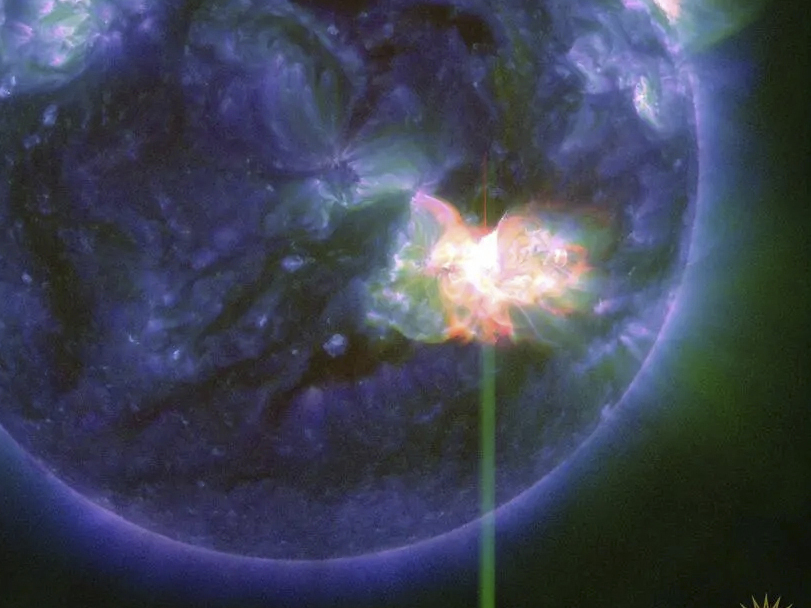
The solar flare as captured by NASA's Solar Dynamics Observatory on May 9, 2024. The flare has triggered a severe geomagnetic storm watch for the first time in nearly 20 years.
AP
Planet Earth is getting rocked by the biggest solar storm in decades.
Late Friday, the National Oceanic and Atmospheric Administration declared that the Earth was experiencing a G5, or "Extreme," geomagnetic storm. This is the first G5 storm to hit the planet since 2003.
NOAA warns several waves of flares will slam into the Earth over the next few hours and days, potentially disrupting communications and navigation, triggering power outages and damaging satellites. The 2003 event briefly knocked out power in part of Sweden and damaged electrical transformers in South Africa.
NOAA's Space Weather Prediction Center says that this latest storm may induce auroras visible as far south as Northern California and Alabama.
On social media, posters were putting up photos of bright auroras visible across Russia, Scandinavia, the U.K. and continental Europe. Some reported seeing the aurora as far south as Mallorca, Spain.
my cat just experienced the aurora borealis, one of the world's most radiant natural phenomena... and she doesn't care pic.twitter.com/Ee74FpWHFm
— PJ (@kickthepj) May 10, 2024
The source of the solar storm is a cluster of sunspots on the sun's surface that is 17 times the diameter of the earth. The spots are filled with tangled magnetic fields that can act as slingshots, throwing huge quantities of charged particles towards our planet. These events, known as Coronal Mass Ejections, become more common during the peak of the Sun's 11-year solar cycle.
Usually, they miss the Earth, but this time, NOAA says several are headed directly towards our planet.
Extreme (G5) geomagnetic conditions have been observed! pic.twitter.com/qLsC8GbWus
— NOAA Space Weather Prediction Center (@NWSSWPC) May 10, 2024
"We have high confidence that a series of coronal mass ejections ... are directed right towards Earth," says Shawn Dahl, service coordinator for the Space Weather Prediction Center told reaporters early Friday.
While they expect the storm to be large, there's still a lot of uncertainty about what the other effects could be, Dahl says.
"I wouldn't want to speculate on that," Dahl says.
Shocking problems
The most disruptive solar storm ever recorded came in 1859. Known as the "Carrington Event," it generated shimmering auroras that were visible as far south as Mexico and Hawaii. It also fried telegraph systems throughout Europe and North America.
While this geomagnetic storm will not be as strong, the world has grown more dependent on electronics and electrical systems. Depending on the orientation of the storm's magnetic field it could induce unexpected electrical currents in long-distance power lines — those currents could cause safety systems to flip, triggering temporary power outages in some areas.
The storm is also likely to disrupt the ionosphere, a section of Earth's atmosphere filled with charged particles. Some long-distance radio transmissions use the ionosphere to "bounce" signals around the globe, and those signals will likely be disrupted. The particles may also refract and otherwise scramble signals from the global positioning system, according to Rob Steenburgh, a space scientist with NOAA. Those effects can linger for a few days after the storm.
Steenburgh says it's unclear just how bad the disruptions will be. While we are more dependent than ever on GPS, there are also more satellites in orbit. Moreover, the anomalies from the storm are constantly shifting through the ionosphere like ripples in a pool. "Outages, with any luck, should not be prolonged," Steenburgh says.
The radiation from the storm could have other undesirable effects. At high altitudes, it could damage satellites, while at low altitudes, it's likely to increase atmospheric drag, causing some satellites to sink toward the Earth.
The changes to orbits wreak havoc, warns Tuija Pulkkinen, chair of the department of climate and space sciences at the University of Michigan. Since the last solar maximum, companies such as SpaceX have launched thousands of satellites into low Earth orbit. Those satellites will now see their orbits unexpectedly changed.
"There's a lot of companies that haven't seen these kind of space weather effects before," she says.
The International Space Station lies within Earth's magnetosphere, so its astronauts should be mostly protected, Steenburgh says.
In a statement, NASA said that astronauts would not take additional measures to protect themselves: "NASA completed a thorough analysis of recent space weather activity and determined it posed no risk to the crew aboard the International Space Station and no additional precautionary measures are needed," the agency said late Friday.

People visit St Mary's lighthouse in Whitley Bay to see the aurora borealis on Friday in Whitley Bay, England.
Ian Forsyth / Getty Images
Do look up
While this storm will undoubtedly keep satellite operators and utilities busy over the next few days, individuals don't really need to do much to get ready.
"As far as what the general public should be doing, hopefully they're not having to do anything," says Dahl. The largest problem could be a brief blackout, so keep some flashlights and a radio handy, he says.
I took these photos near Ranfurly in Central Otago, New Zealand. Anyone can use them please spread far and wide. :-) https://t.co/NUWpLiqY2S
— Dr Andrew Dickson reform/ACC (@AndrewDickson13) May 10, 2024
And don't forget to go outside and look up, adds Steenburgh. This event's aurora is visible much further south than usual.
A faint aurora can be detected by a modern cell phone camera, he adds, so even if you can't see it with your eyes, try taking a photo of the sky.
The aurora "is really the gift from space weather," he says.
Copyright 2024 NPR. To see more, visit https://www.npr.org.